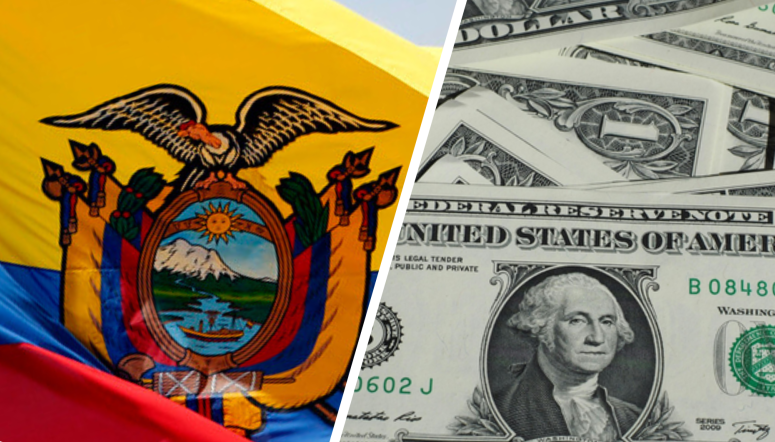
Ecuador: Dollarization Turns 25
Ecuadorians spontaneously dollarized before politicians formalized it.
BY JUAN POLLIO
Simalco
Dollarization has turned a quarter of a century old in Ecuador and is more current than ever among the population. What are the keys to its success and its difficulties, according to experts?
On Sunday, January 9, 2000, Ecuadorian President Jamil Mahuad made the desperate decision to implement the dollarization of Ecuador’s economy in an attempt to stabilize the country, mired in an unprecedented economic crisis: bankruptcy of the financial system, freezing of savers’ deposits and rampant inflation that rose from 23% annually in 1995 to 91% in 2000.
Thirteen days later, Mahuad would be deposed as a result of strong social pressure, indigenous uprisings and, above all, the withdrawal of support by the Armed Forces, which deposed him and placed his vice president as the new president, Gustavo Noboa.
However, this would not be the end of dollarization in Ecuador. On the contrary, 25 years later, dollarization is one of the longest-lasting and most popular public policies in the history of the country, with an approval rating in polls close to 90%. This is no small feat in a country that had 21 different constitutions, the longest of which lasted 22 years.
“POPULAR” DOLLARIZATION
The analyst in trade and international politics of the Ecuadorian Institute of Political Economy (IEEP) Gabriela Calderón argued that “the reason dollarization has lasted so long in Ecuador has to do with how it arose and what it is based on: it was not imposed from the top down, but was really a popular phenomenon, that is, from the bottom up.”
“We tried everything, particularly between 1995 and 2000: the crawling peg (daily micro-devaluations), totally free floating, with a nominal fixed exchange rate. Everything was tried and there was still a lack of confidence in the national currency. There were even governments that had fiscal discipline, but everything ended up exploding because every time there was a political problem, people got nervous and ran against the sucre (the national currency at the time),” she recalled.
Calderón argued that “people spontaneously dollarized before politicians formalized dollarization.” By 1999, durable goods transactions were already negotiated in dollars, “what was missing was that one could pay taxes in dollars, have them deposited in an account, collect their salary in dollars and enter into contracts in dollars. But in practice, people had dollarized and kept their savings in dollars outside the financial system.”
After dollarization, that confidence in the banking system began to return, with “a growth in deposits that was not interrupted even by the earthquake in 2016, or by the pandemic or the two violent National Strikes that have occurred.” The data supports her. In 2000, demand deposits in Ecuador were only $948.5 million, by 2009 they rose to $4,902.2 million and by October 2024, the latest official data, they totaled $10,477.7 million.
INSTITUTIONAL FRAGILITY
A common conclusion among experts is that the weak institutionality that exists in Ecuador was one of the causes of the population abandoning the sucre. “Dollarization is the institution that has lasted the longest in the entire republican history of Ecuador,” said IEEP economist Francisco Zalles, one of the leaders in the dollarization process and former advisor to Noboa during his presidency.
“There is no formal institutionality in Ecuador, the only institutionality that has survived and is popular is the dollar,” he emphasized. In her opinion, dollarization occurred “because the Central Bank’s attempts to be a serious institution, to not be manipulated and to not create misery were a failure.”
For this reason, Zalles argued that the dollar “is the will of individual citizens to express their preference for currencies in order to be able to trade and keep their savings as far away from political power as possible.”
This is a diagnosis that economist Gabriela Calderón agrees with, since she considers that dollarization “is a divorce of politics from the financial system and from the money in which people save.” And she added: “That is why it is maintained, because ordinary people do not trust the political class and they like that their money has nothing to do with it.”
PERU: THE ALTERNATIVE TO DOLLARIZATION
Former Vice Minister of Foreign Trade of Ecuador José Orellana Giler acknowledged that dollarization “is not a perfect system, but there is no perfect exchange rate system.” For this reason, he maintained that “the monetary system is important in terms of the confidence there is in the government.” He cited the case of Peru, which unlike Ecuador, carried out an orthodox plan known as the “Fujishock” and with which macroeconomic stability was also achieved.
“Peru has very important laws in the Constitution that separate the economic and political aspects quite a bit. They made those changes that allow the Peruvian sol to be very stable as a currency and allow for a lot of foreign investment,” he explained.
Gabriela Calderón said: “For about 15 years, we have been one of the worst countries in the region in terms of attracting foreign investment and since 2017 there have been no international bilateral treaties, but that has more to do with the legal system and the reputation of our courts.”
And she added: “We do not have this protection from this system of arbitration chambers, as they do in Peru, which does not depend exclusively on the Judicial Branch of the Peruvian State, but there are private mechanisms in which the parties can voluntarily agree.”
As a comparison, during 2023 Foreign Direct Investment (FDI) in Peru was US$ 30,172 million. During that same year, FDI in Ecuador was only US$ 409.5 million, after a peak reached in 2016 of US$ 1,389 million.
NEED TO IMPROVE PRODUCTIVITY
The need for foreign investment is particularly necessary in Ecuador, which uses a hard currency, such as the US dollar, and which also follows the fluctuations of the economic policy of a country other than the one that uses it.
“Economic policy is managed by the United States Federal Reserve, so if they raise or lower interest rates it affects us without us being able to do anything, but when was it different?,” asked José Orellana Giler.
For this reason, he stated that “the best defense is to be productive and that also implies accepting that certain industries are not going to stay and other industries have to come. For example, computer centers.”
Gabriela Calderón had a similar opinion, since she maintained that after dollarization «companies in general had no other option than to concentrate on real competitiveness». As a consequence, «sectors that were competitive at a global level without subsidies from exchange rate policy are beginning to be discovered».
THE SHRIMP BOOM AND THE CHALLENGES AHEAD
One of the sectors that grew strongly was shrimp exports. Economist Francisco Zalles stated that “dollarization has managed to make private sector exports grow constantly, to the point that one in four shrimp consumed in the world are Ecuadorian and that is since dollarization.”
On this point, Orellana explained: “Ecuador sells between $ 7 billion and $8 billion of shrimp to the world, it is the largest producer of shrimp. There have been industries that, although they existed, but in a smaller form, have also developed thanks to the availability of longer-term credits, with years of grace and with lower rates, because the banks did not have to protect themselves from a devaluation.”
In 2016, shrimp exports totaled $2.58 billion, while in 2023 they reached $7.205 billion, placing it just below crude oil ($7.823 billion), Ecuador’s main export and on which, according to Orellana, there is still “a very strong dependence”, among other reasons, because “in Ecuador productivity has not grown as much as it should.”
He added: “Ecuador has immense mining potential, but the development process of the sector has been very slow, as with natural gas, where there are also opportunities, but they have not been developed.”
This article was originally published by Simalco. Republished with permission.
RELATED ARTICLES
Hanke: Dollarization Helped Ecuador












